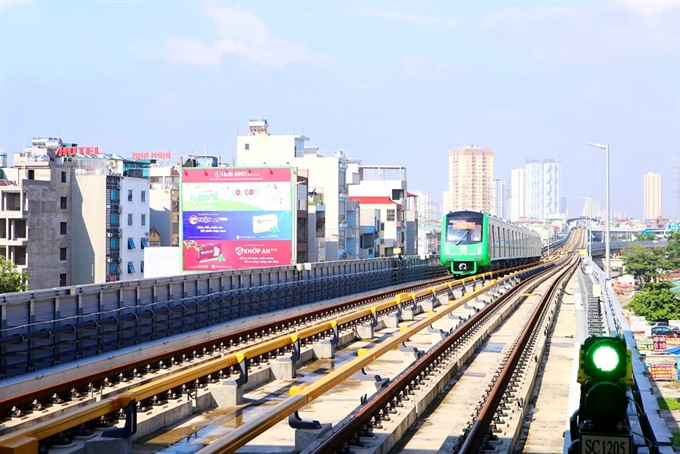Hanoi to see 417km metro rail till 2050
Hanoi’s Urban Transport Master Plan until 2030 with a vision to 2050 outlines the development for a core urban zone and additional satellite cities.
According to the plan, the Hanoi metro system will run a total length of 417km, of which approximately 76km will be underground. The planned lines are as follows:
Line 1
Ngọc Hồi – Yên Viên – Như Quỳnh, with two sections: Ngọc Hồi – Yên Viên and Gia Lâm – Dương Xá.
Line 2
Nội Bài – Thượng Đình – Bưởi, with further sections: Nam Thăng Long – Trần Hưng Đạo; Trần Hưng Đạo - Thượng Đình; Thượng Đình - Belt Road 2 – Bưởi; Nội Bài – Thăng Long; and an extension of Line 2 to Sóc Sơn District.
Line 2A
Cát Linh – Hà Đông - Xuân Mai, with sections: Cát Linh – Hà Đông, and an extension of the Xuân Mai section.
Line 3
Trôi – Nhổn – Yên Sở, with sections: Nhổn – Hanoi Railway Station; Trôi – Nhổn; Hanoi Railway Station – Yên Sở – Hoàng Mai; and an extension to Sơn Tây Town.
Line 4
Mê Linh – Sài Đồng – Liên Hà
Line 5
Văn Cao – Hòa Lạc, with two sections: Văn Cao – Belt Road 4 and Belt Road 4 – Hòa Lạc
Line 6
Nội Bài – Ngọc Hồi
Line 7
Mê Linh – Hà Đông
Line 8
Sơn Đồng – Mai Dịch – Dương Xá, including two sections: Sơn Đồng – Mai Dịch and Mai Dịch – Belt Road 3 – Dương Xá
Additional line
Sơn Tây – Hòa Lạc – Xuân Mai Route, connecting to satellite urban areas.
According to the plan, nine sections of four lines will be in operation by 2025. Line 2A (Cát Linh – Hà Đông) is operating test rides and is expected to be in operation in 2019. Line 3 (Nhổn – Hanoi Railway Station) is accelerating construction and is expected to open the elevated section by 2020, with the remainder of the line operational by 2022. Line 2 (Trần Hưng Đạo – Nam Thăng Long) still needs design approval and investment.
With an annual growth rate of 7 per cent, Vietnam is one of the fastest-growing economies in Asia. Vietnam’s cities are also experiencing rapid growth. It is expected that 50 per cent of the population will live in urban areas by 2025. As the country’s capital, the city needs to develop a transportation infrastructure accordingly.
Currently, public transport in Hanoi consists of only buses and taxis. There are two types of buses, regular buses and BRT buses. Once completed, this metro system, together with the current bus system, will be the backbone of the city’s public transport network.

Once completed, the 417km long metro rail system, together with the current bus system,
will be the backbone of the city’s public transport system
According to the plan, the Hanoi metro system will run a total length of 417km, of which approximately 76km will be underground. The planned lines are as follows:
Line 1
Ngọc Hồi – Yên Viên – Như Quỳnh, with two sections: Ngọc Hồi – Yên Viên and Gia Lâm – Dương Xá.
Line 2
Nội Bài – Thượng Đình – Bưởi, with further sections: Nam Thăng Long – Trần Hưng Đạo; Trần Hưng Đạo - Thượng Đình; Thượng Đình - Belt Road 2 – Bưởi; Nội Bài – Thăng Long; and an extension of Line 2 to Sóc Sơn District.
Line 2A
Cát Linh – Hà Đông - Xuân Mai, with sections: Cát Linh – Hà Đông, and an extension of the Xuân Mai section.
Line 3
Trôi – Nhổn – Yên Sở, with sections: Nhổn – Hanoi Railway Station; Trôi – Nhổn; Hanoi Railway Station – Yên Sở – Hoàng Mai; and an extension to Sơn Tây Town.
Line 4
Mê Linh – Sài Đồng – Liên Hà
Line 5
Văn Cao – Hòa Lạc, with two sections: Văn Cao – Belt Road 4 and Belt Road 4 – Hòa Lạc
Line 6
Nội Bài – Ngọc Hồi
Line 7
Mê Linh – Hà Đông
Line 8
Sơn Đồng – Mai Dịch – Dương Xá, including two sections: Sơn Đồng – Mai Dịch and Mai Dịch – Belt Road 3 – Dương Xá
Additional line
Sơn Tây – Hòa Lạc – Xuân Mai Route, connecting to satellite urban areas.
According to the plan, nine sections of four lines will be in operation by 2025. Line 2A (Cát Linh – Hà Đông) is operating test rides and is expected to be in operation in 2019. Line 3 (Nhổn – Hanoi Railway Station) is accelerating construction and is expected to open the elevated section by 2020, with the remainder of the line operational by 2022. Line 2 (Trần Hưng Đạo – Nam Thăng Long) still needs design approval and investment.
With an annual growth rate of 7 per cent, Vietnam is one of the fastest-growing economies in Asia. Vietnam’s cities are also experiencing rapid growth. It is expected that 50 per cent of the population will live in urban areas by 2025. As the country’s capital, the city needs to develop a transportation infrastructure accordingly.
Currently, public transport in Hanoi consists of only buses and taxis. There are two types of buses, regular buses and BRT buses. Once completed, this metro system, together with the current bus system, will be the backbone of the city’s public transport network.

Leave your comment on this story